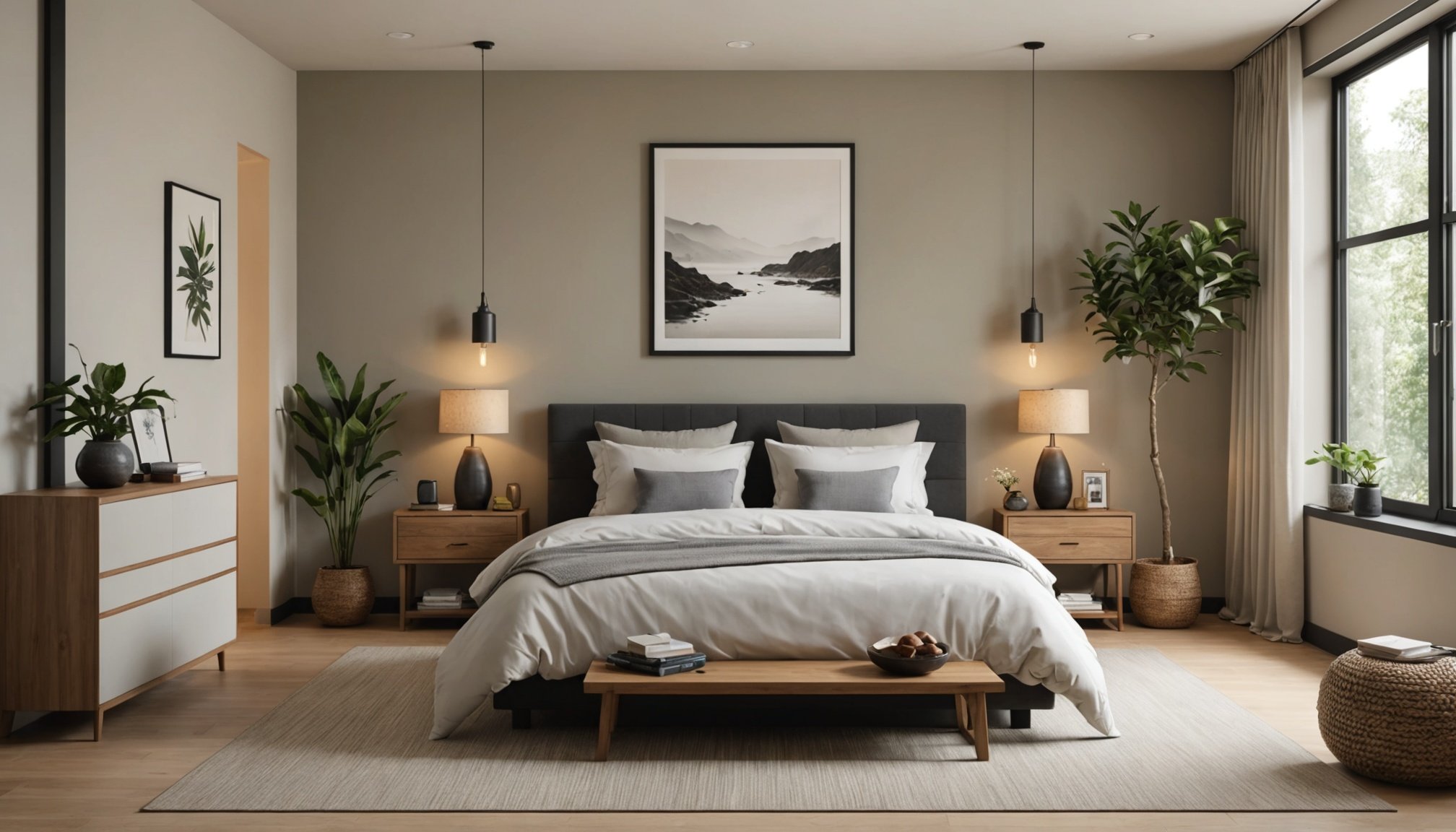Understanding Zen Retreat Concepts
A Zen retreat embodies more than just a mere escape; it is steeped in historical and cultural significance. Rooted in ancient wellness traditions, these retreats offer a sanctuary for individuals seeking mindfulness and serenity. The design principles pivotal to these retreats revolve around creating a space that fosters introspection and relaxation. Essential design elements incorporate simplicity, subtlety, and a seamless blend with nature.
Mindfulness is at the core of Zen retreat philosophy, inviting individuals to engage in the present moment. The environment is thoughtfully curated to enhance this experience, as our surroundings greatly influence mood and relaxation. Nature plays a vital role here. Incorporating natural elements like stones, plants, and water features not only connects the individual to the earth but also promotes tranquility and reflection.
Also read : Transform Your Terrace Garden: An Expert’s Guide to Rainwater Harvesting Installation
The setting aims to offer a relaxation space that soothes the senses and calms the mind. Light, sound, and textures are meticulously chosen to enhance the user’s experience of the retreat. Thus, selecting natural materials and minimalist designs contribute to the invigorating yet peaceful atmosphere inherent to Zen retreats, ensuring an escape from daily turmoil, and a journey into calm mindfulness.
Selecting the Right Color Palette
Understanding color psychology is a vital aspect when designing a calming and peaceful space. Zen retreats often embrace hues that promote relaxation and serenity. Peaceful colors such as soft blues, gentle greens, and muted earth tones can effectively evoke tranquility, aiding in the cultivation of mindfulness. These hues not only soothe the senses but also harmonize with nature, emphasizing the minimalist and tranquil atmosphere inherent in a Zen retreat.
This might interest you : Crafting Personalized Storage Solutions for Your Artisan Home Bakery: Essential Tips for Bread Aficionados
The selection of zen colors should consider color schemes that complement each other, ensuring the space feels cohesive and balanced. Neutral palettes that incorporate varying shades of white, beige, and grey are popular choices. These colors act as a backdrop, allowing natural elements in the room to stand out, enhancing the connection to the natural environment.
When incorporating these colors into the decor, consider using natural materials that reflect similar tones. This could mean selecting wooden furniture pieces, stone accents, or textile choices that mirror nature. By doing so, the space will naturally invite calmness and introspection, critical to the core values of a Zen retreat. Thoughtful color selection transforms a retreat space into a haven, fostering an atmosphere of peace and relaxation.
Furniture Selection for Comfort and Functionality
Selecting the right Zen furniture is crucial in crafting a space that promotes functionality and comfort while enhancing mindfulness. Central to this is finding furniture that seamlessly combines aesthetics with practical use.
When considering furniture for a Zen retreat, one should prioritize pieces that offer both comfort and versatility. For instance, a low-profile seating arrangement, like a cushioned floor seating, not only emphasizes simplicity but also encourages introspection and meditation. Another example is using a futon-style sofa, which can double as a bed, providing a space-efficient solution without sacrificing comfort.
Equally important is the layout and flow of the space. Good space management ensures a room feels open and uncluttered, reinforcing the relaxation space. Arranging Zen furniture to allow for smooth transitioning between areas helps maintain a calm and inviting atmosphere.
Additionally, the choice of materials greatly impacts the overall experience. Opting for natural materials such as bamboo or rattan aligns with the Zen philosophy, evoking a sense of warmth and connection to nature. In summary, thoughtful selection and arrangement of Zen furniture play a pivotal role in creating an environment conducive to relaxation and mindfulness.
Decor Tips to Enhance Tranquility
Creating a soothing environment through decor is quintessential for a Zen retreat. Zen decor focuses on minimalism, emphasizing simplicity to nurture tranquility. Avoid clutter, choosing pieces that are both functional and understated, such as simple wooden art or handcrafted pottery. This promotes an atmosphere conducive to mindfulness.
Ideas for Minimalist Decor
Minimalist decor aligns with the Zen aesthetic, where less is more. Incorporate clean lines and uncluttered spaces, selecting decor that echoes nature’s simplicity. For example, using neutral ceramics or glass vases invites elegance without overwhelming the senses.
Use of Natural Elements
To ground the atmosphere, integrate natural textures and elements. Natural materials such as bamboo, stone, or linen can be used in rugs, curtains, or wall art, bringing an organic touch to interiors. Their textures provide a tactile connection to nature, enhancing tranquility.
Incorporating Calming Elements
Calming elements like soft cushions or aromatic candles further elevate the ambiance. Choose colors and items that evoke serenity, harmonizing them with the space’s natural elements. Each piece of decor should serve a purpose, contributing to an overall sense of calm and balance in the room.
Lighting Options for a Peaceful Atmosphere
Crafting a peaceful atmosphere in a Zen retreat requires an intentional approach to lighting. Proper lighting not only enhances the mood but also supports mindfulness and tranquility.
The Role of Natural Light
Natural light is a vital component of a serene environment. It harmonizes with the Zen retreat’s natural elements, promoting a balanced and calm space. Maximize natural light by using sheer or light-coloured curtains that softly diffuse sunlight. Placing seating areas near windows can create an inviting relaxation space.
Ambient Lighting Choices
In instances where natural light is insufficient, ambient lighting plays a crucial role. Consider using floor lamps and pendant lights with dimming capabilities. These offer flexibility, allowing users to adjust the lighting to suit different times of the day, effectively fostering a serene environment.
Tips for Soft and Adjustable Lighting
Emphasize the use of soft lighting to avoid harsh shadows that might disrupt relaxation. Incorporating lamps with adjustable settings provides control over the intensity and warmth of the light. This not only ensures comfort but also contributes to guest comfort and the overall soothing experience within the retreat. Strategically placed candles or LED bulbs with warm tones can also enhance a calm and intimate atmosphere.
Incorporating Sensory Elements
Incorporating sensory elements transforms a Zen retreat into a sanctuary of tranquility. One pivotal element is aromatherapy, designed to enhance relaxation and mood. Aromatic essential oils such as lavender or chamomile can be diffused throughout the room, inviting a sense of calm and relaxation. These scents are known for their soothing properties, effectively reducing stress and promoting well-being.
Adding a layer to this sensory experience, soundscapes and calming music play a crucial role. Soft, ambient sounds, like gentle rain or the rustling leaves, can mask external noises, creating a cocoon of peace. Music with slow tempos further supports meditation and mindfulness, enhancing the overall tranquility sought after in a Zen retreat.
Tactile materials also contribute significantly. Introducing elements like soft woolen blankets or cotton throws amplifies the tactile sensory experience, grounding individuals in the present moment. Materials that are pleasing to touch will inevitably contribute to the soothing environment, allowing guests to truly sink into relaxation.
Together, these sensory elements orchestrate a harmonious atmosphere, enriching the sensory experience and ensuring the retreat remains an oasis of calm and serenity. Each carefully chosen element adds a layer of sophistication and depth, essential for true relaxation.
Maintaining a Peaceful Atmosphere
Ensuring room maintenance is not just about cleanliness; it’s about preserving a serene environment in a Zen retreat. A clutter-free space is central to maintaining tranquility. Take steps like routine decluttering to prevent disruption of the calming energy essential to mindfulness. Regular checks ensure the room remains a sanctuary, free from stress-inducing disarray.
Mindful upkeep is equally important. It involves routine assessments to identify areas needing updates or repairs. Emphasize natural elements, like replacing worn materials with organic textiles. This not only sustains the retreat’s ambiance but enhances the connection to nature.
Another strategy is reevaluating decor items periodically. Introduce new textures or calming elements to revitalize the space, while maintaining the minimalist aesthetic inherent in Zen environments. Keep the layout harmonious to prevent stagnation in energy flow, ensuring the room feels refreshing.
Lastly, engage in regular modifications that complement the retreat’s core design principles. This could involve swapping textiles to reflect seasonal changes or refreshing peaceful colors to maintain a balanced atmosphere. By integrating these thoughtful approaches, a Zen retreat remains a true escape from daily chaos, continually supporting a guest’s journey into mindfulness.
Practical Considerations for Guests
Creating a welcoming and functional guest space in a Zen retreat requires more than just a stylish design; it demands attention to guest comfort and personalization. Essential amenities such as cozy blankets, soft pillows, and refreshing toiletries ensure that guests feel both pampered and at ease. A comfortable room also means having easy-to-use spaces like reading nooks or meditation zones, enhancing relaxation.
Personalized Touches
To cater to individual preferences, consider adding personalized touches. This could include offering a selection of books or music that aligns with the Zen philosophy, or even providing a journal for guests to record their reflections. Tailor small elements to guest interests, making the experience unique and memorable.
Balancing Aesthetics with Functionality
Achieving the perfect balance between aesthetics and functionality is crucial. While the space must appear serene and cohesive, it should also meet practical needs. Opt for multi-functional furniture pieces, such as a small desk doubling as a meditation altar. Ensure pathways and access points are clear, allowing guests to move freely, maintaining the sense of tranquility while upholding necessary functionalities. This thoughtful approach to design ensures guests enjoy a seamless, restorative visit, emphasizing both beauty and utility.





